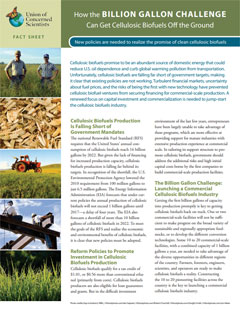Advanced Biofuels from diverse sources such as grasses and agricultural waste are struggling to become a viable industry despite their significant environmental advantages. With high initial capital costs, and ethanol tax credits set to expire at the end of 2010, investors are wary. If the advanced biofuels industry is going to have a chance to reduce oil dependence and global warming pollution, the federal government must adopt new policies to promote investment.
The key to getting advanced biofuels on track is to get the first billion gallons of the fuel to market. This requires the capital to build 10-20 new facilities across the country. The Billion Gallon Challenge shows how an investment tax credit of 30 percent and loan guarantees for the first billion gallons can help promote investment.
The benefits of boosting advanced biofuels production include:
- A new industry that produces clean fuels and jobs across the country
- Reduce gasoline consumption by seven billion gallons by 2022
- Reduce global warming emissions by 45 million metric tons a year in 2022
Biofuels have an important role to play in the clean energy economy and in addressing global warming. With sensible tax credits and loan guarantees, the advanced biofuels industry is more likely to succeed.




